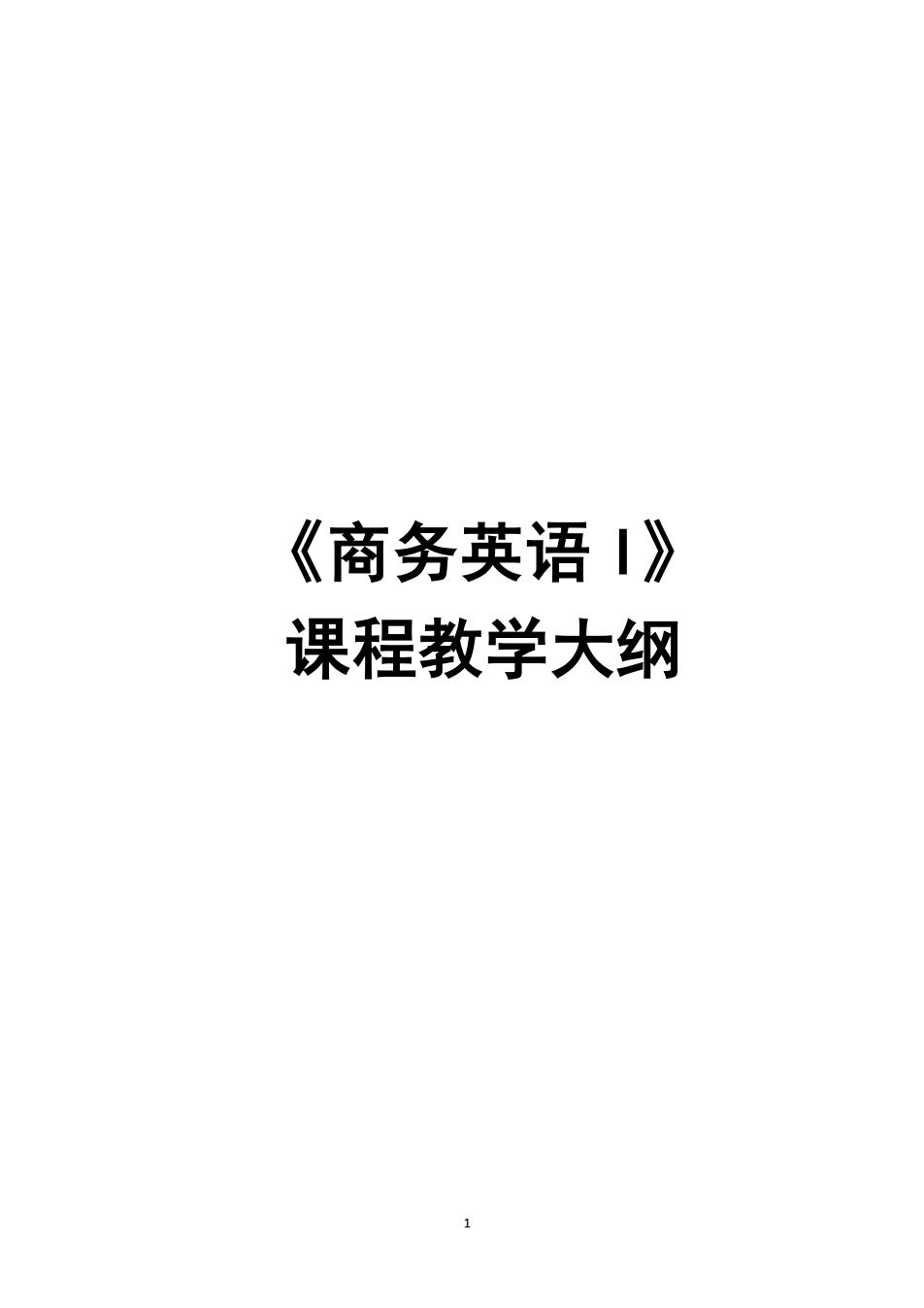
《商务英语I》 课程教学大纲
1 《商务英语 I》 课程教学大纲
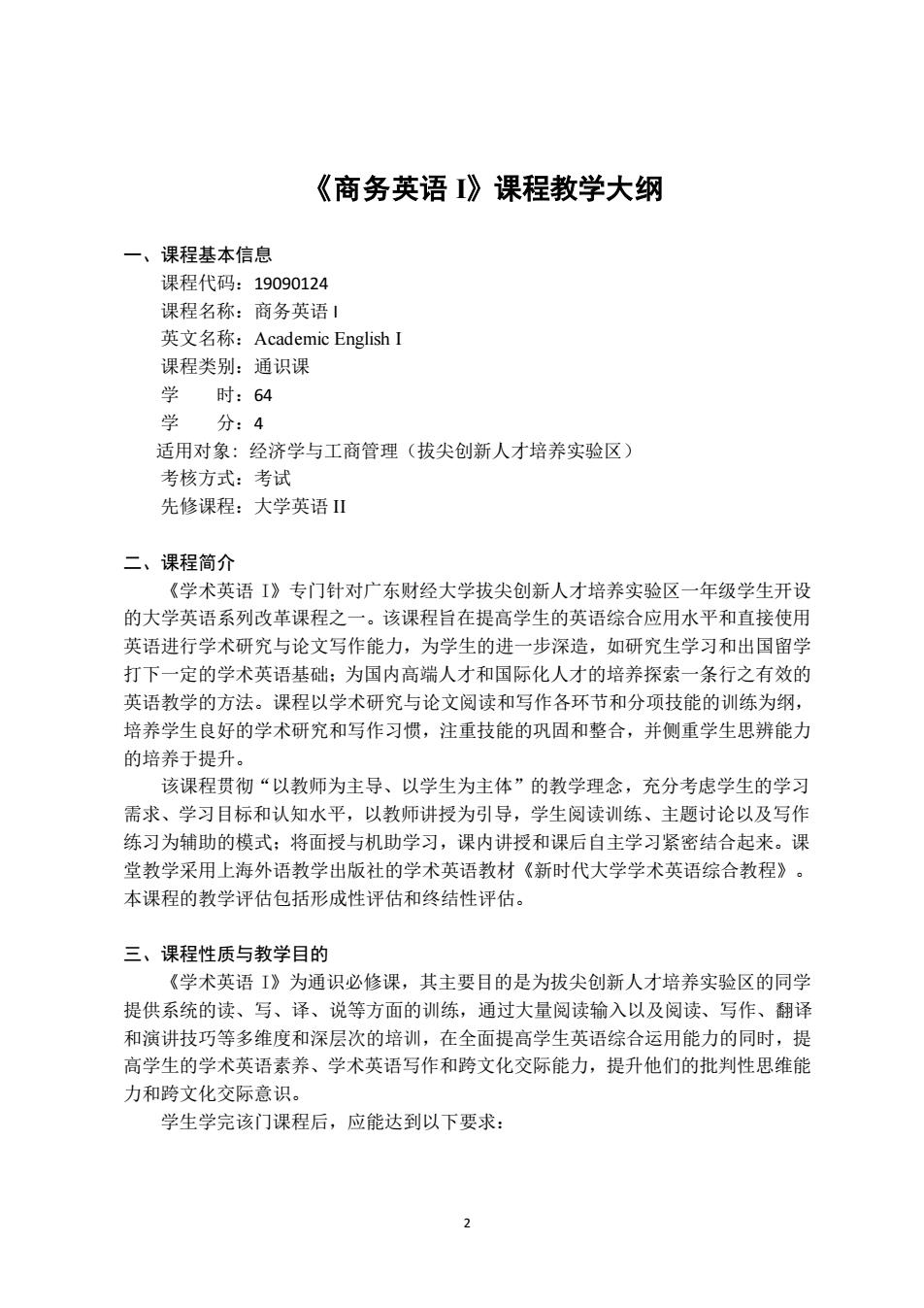
《商务英语》课程教学大纲 一、课程基本信息 课程代码:19090124 课程名称:商务英语! 英文名称:Academic English I 课程类别:通识课 时:64 学 分分:4 适用对象:经济学与工商管理(拔尖创新人才培养实验区) 考核方式:考试 先修课程:大学英语 二、课程简介 《学术英语[》专门针对广东财经大学拔尖创新人才培养实验区一年级学生开设 的大学英语系列改革课程之一。该课程旨在提高学生的英语综合应用水平和直接使用 英语进行学术研究与论文写作能力,为学生的进一步深造,如研究生学习和出国留学 打下一定的学术英语基础:为国内高端人才和国际化人才的培养探索一条行之有效的 英语教学的方法。课程以学术研究与论文阅读和写作各环节和分项技能的训练为纲, 培养学生良好的学术研究和写作习惯,注重技能的巩固和整合,并侧重学生思辨能力 的培养于提升。 该课程贯彻“以教师为主导、以学生为主体”的教学理念,充分考虑学生的学习 需求、学习目标和认知水平,以教师讲授为引导,学生阅读训练、主题讨论以及写作 练习为辅助的模式:将面授与机助学习,课内讲授和课后自主学习紧密结合起来。课 堂教学采用上海外语教学出版社的学术英语教材《新时代大学学术英语综合教程》 本课程的教学评估包括形成性评估和终结性评估。 三、课程性质与教学目的 《学术英语I》为通识必修课,其主要目的是为拔尖创新人才培养实验区的同学 提供系统的读、写、译、说等方面的训练,通过大量阅读输入以及阅读、写作、翻译 和演讲技巧等多维度和深层次的培训,在全面提高学生英语综合运用能力的同时,提 高学生的学术英语素养、学术英语写作和跨文化交际能力,提升他们的批判性思维能 力和跨文化交际意识。 学生学完该门课程后,应能达到以下要求: 2
2 《商务英语 I》课程教学大纲 一、课程基本信息 课程代码:19090124 课程名称:商务英语 I 英文名称:Academic English I 课程类别:通识课 学 时:64 学 分:4 适用对象: 经济学与工商管理(拔尖创新人才培养实验区) 考核方式:考试 先修课程:大学英语 II 二、课程简介 《学术英语 I》专门针对广东财经大学拔尖创新人才培养实验区一年级学生开设 的大学英语系列改革课程之一。该课程旨在提高学生的英语综合应用水平和直接使用 英语进行学术研究与论文写作能力,为学生的进一步深造,如研究生学习和出国留学 打下一定的学术英语基础;为国内高端人才和国际化人才的培养探索一条行之有效的 英语教学的方法。课程以学术研究与论文阅读和写作各环节和分项技能的训练为纲, 培养学生良好的学术研究和写作习惯,注重技能的巩固和整合,并侧重学生思辨能力 的培养于提升。 该课程贯彻“以教师为主导、以学生为主体”的教学理念,充分考虑学生的学习 需求、学习目标和认知水平,以教师讲授为引导,学生阅读训练、主题讨论以及写作 练习为辅助的模式;将面授与机助学习,课内讲授和课后自主学习紧密结合起来。课 堂教学采用上海外语教学出版社的学术英语教材《新时代大学学术英语综合教程》。 本课程的教学评估包括形成性评估和终结性评估。 三、课程性质与教学目的 《学术英语 I》为通识必修课,其主要目的是为拔尖创新人才培养实验区的同学 提供系统的读、写、译、说等方面的训练,通过大量阅读输入以及阅读、写作、翻译 和演讲技巧等多维度和深层次的培训,在全面提高学生英语综合运用能力的同时,提 高学生的学术英语素养、学术英语写作和跨文化交际能力,提升他们的批判性思维能 力和跨文化交际意识。 学生学完该门课程后,应能达到以下要求:
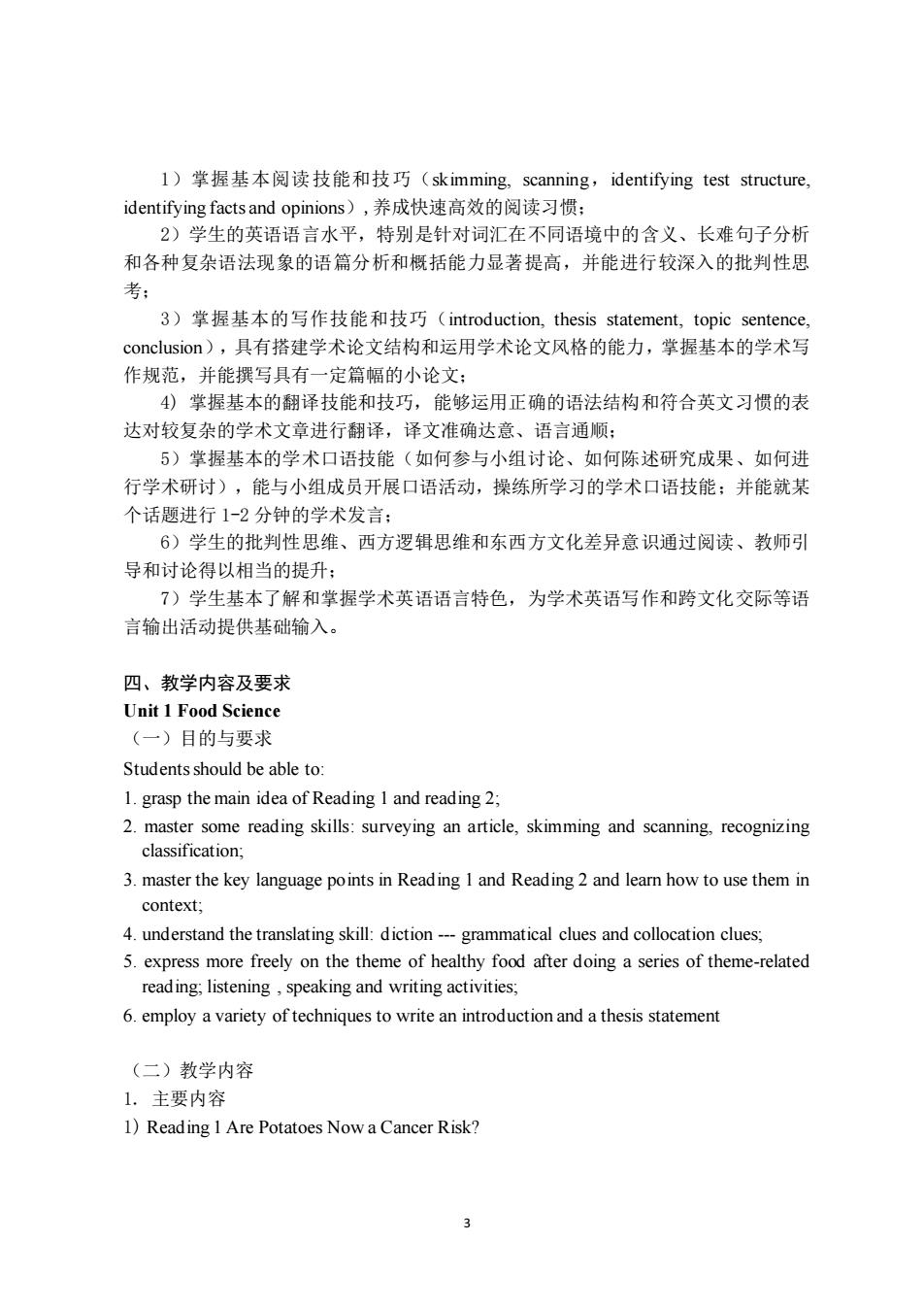
1)掌握基本阅读技能和技巧(skimming,scanning,identifying test structure. identifying factsand opinions),养成快速高效的阅读习惯: 2)学生的英语语言水平,特别是针对词汇在不同语境中的含义、长难句子分析 和各种复杂语法现象的语篇分析和概括能力显著提高,并能进行较深入的批判性思 3)掌握基本的写作技能和技巧(introduction,thesis statement,.topic sentence, conclusion),具有搭建学术论文结构和运用学术论文风格的能力,掌握基本的学术写 作规范,并能撰写具有一定篇幅的小论文: 4)掌握基本的翻译技能和技巧,能够运用正确的语法结构和符合英文习惯的表 达对较复杂的学术文章进行翻译,译文准确达意、语言通顺: 5)掌握基本的学术口语技能(如何参与小组讨论、如何陈述研究成果、如何进 行学术研讨),能与小组成员开展口语活动,操练所学习的学术口语技能:并能就某 个话题进行1-2分钟的学术发言: 6)学生的批判性思维、西方逻辑思维和东西方文化差异意识通过阅读、教师引 导和讨论得以相当的提升: 7)学生基本了解和堂握学术英语语言特色,为学术英语写作和跨文化交际等语 言输出活动提供基础输入。 四、教学内容及要求 Unit 1 Food Science (一)目的与要求 Students should be able to: 1.grasp the main idea of Reading I and reading 2, 2.master some reading skills:surveying an article,skimming and scanning.recognizing classification, 3.master the key language points in Reading 1 and Reading 2 and leam how to use them in context; 4.understand the translating skill:diction-grammatical clues and collocation clues: 5.express more freely on the theme of healthy food after doing a series of theme-related reading;listening,speaking and writing activities; 6.employ a variety of techniques to write an introduction and a thesis statement (二)教学内容 1.主要内容 1)Reading I Are Potatoes Now a Cancer Risk? 3
3 1)掌握基本阅读技能和技巧(skimming, scanning,identifying test structure, identifying facts and opinions),养成快速高效的阅读习惯; 2)学生的英语语言水平,特别是针对词汇在不同语境中的含义、长难句子分析 和各种复杂语法现象的语篇分析和概括能力显著提高,并能进行较深入的批判性思 考; 3)掌握基本的写作技能和技巧(introduction, thesis statement, topic sentence, conclusion),具有搭建学术论文结构和运用学术论文风格的能力,掌握基本的学术写 作规范,并能撰写具有一定篇幅的小论文; 4) 掌握基本的翻译技能和技巧,能够运用正确的语法结构和符合英文习惯的表 达对较复杂的学术文章进行翻译,译文准确达意、语言通顺; 5)掌握基本的学术口语技能(如何参与小组讨论、如何陈述研究成果、如何进 行学术研讨),能与小组成员开展口语活动,操练所学习的学术口语技能;并能就某 个话题进行 1-2 分钟的学术发言; 6)学生的批判性思维、西方逻辑思维和东西方文化差异意识通过阅读、教师引 导和讨论得以相当的提升; 7)学生基本了解和掌握学术英语语言特色,为学术英语写作和跨文化交际等语 言输出活动提供基础输入。 四、教学内容及要求 Unit 1 Food Science (一)目的与要求 Students should be able to: 1. grasp the main idea of Reading 1 and reading 2; 2. master some reading skills: surveying an article, skimming and scanning, recognizing classification; 3. master the key language points in Reading 1 and Reading 2 and learn how to use them in context; 4. understand the translating skill: diction --- grammatical clues and collocation clues; 5. express more freely on the theme of healthy food after doing a series of theme-related reading; listening , speaking and writing activities; 6. employ a variety of techniques to write an introduction and a thesis statement (二)教学内容 1. 主要内容 1) Reading 1 Are Potatoes Now a Cancer Risk?
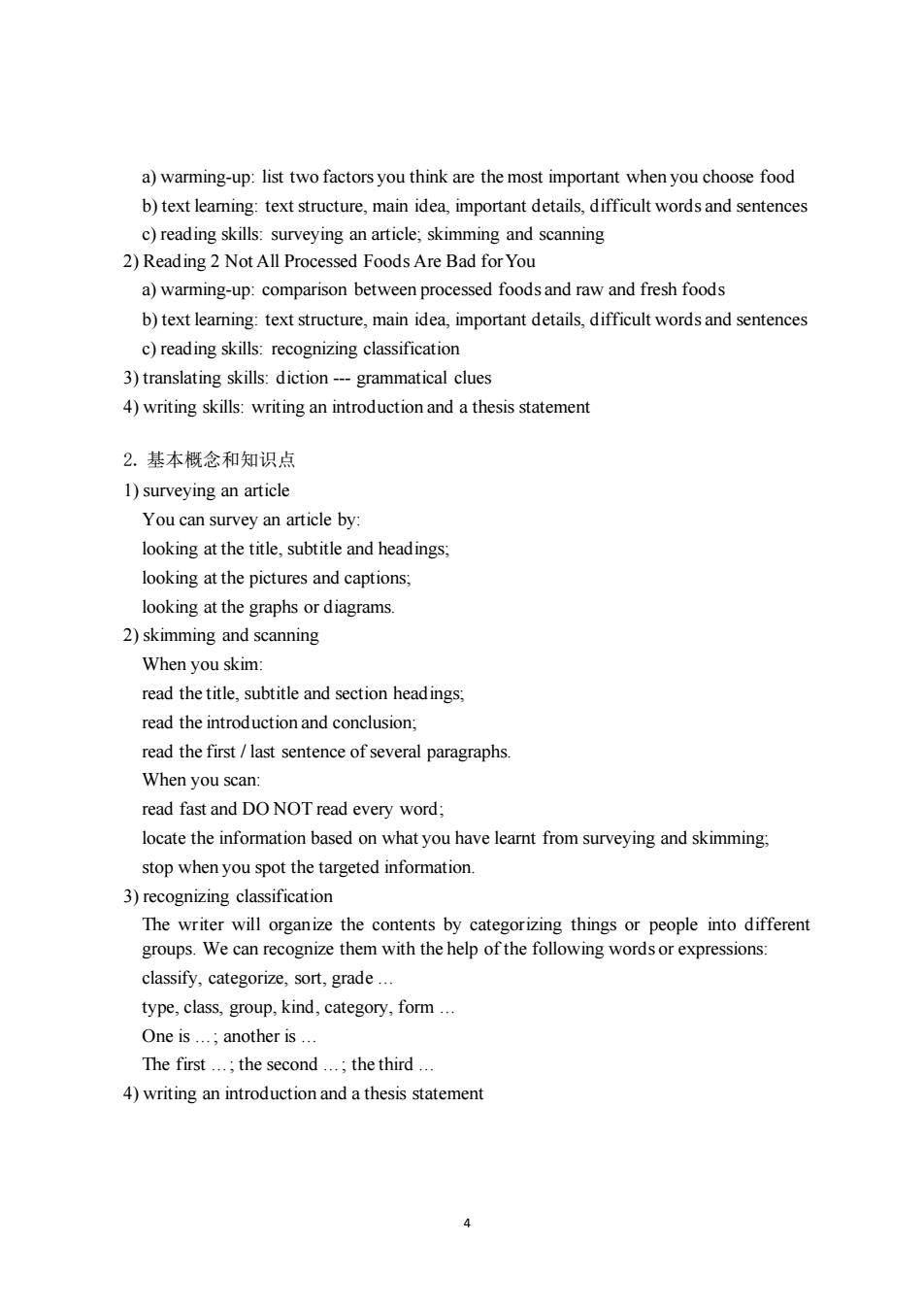
a)warming-up:list two factors you think are the most important when you choose food b)text leaming:text structure,main idea,important details,difficult words and sentences c)reading skills:surveying an article;skimming and scanning 2)Reading 2 NotAll Processed Foods Are Bad for You a)warming-up:comparison between processed foods and raw and fresh foods b)text leaming:text structure,main idea,important details,difficult words and sentences c)reading skills:recognizing classification 3)translating skills:diction--grammatical clues 4)writing skills:writing an introduction and a thesis statement 2.基本概念和知识点 1)surveying an article You can survey an article by: looking at the title,subtitle and headings looking at the pictures and captions; looking at the graphs or diagrams 2)skimming and scanning When you skim: read the title,subtitle and section headings read the introduction and conclusion; read the first/last sentence of several paragraphs When you scan read fast and DO NOT read every word: locate the information based on what you have leamt from surveying and skimming stop when you spot the targeted information. 3)recognizing classification The writer will organize the contents by categorizing things or people into different groups.We can recognize them with the help of the following words or expressions classify,categorize,sort,grade.. type,class,group,kind,category,form... One is..;another is The first...:the second...:the third... 4)writing an introduction and a thesis statement
4 a) warming-up: list two factors you think are the most important when you choose food b) text learning: text structure, main idea, important details, difficult words and sentences c) reading skills: surveying an article; skimming and scanning 2) Reading 2 Not All Processed Foods Are Bad for You a) warming-up: comparison between processed foods and raw and fresh foods b) text learning: text structure, main idea, important details, difficult words and sentences c) reading skills: recognizing classification 3) translating skills: diction --- grammatical clues 4) writing skills: writing an introduction and a thesis statement 2. 基本概念和知识点 1) surveying an article You can survey an article by: looking at the title, subtitle and headings; looking at the pictures and captions; looking at the graphs or diagrams. 2) skimming and scanning When you skim: read the title, subtitle and section headings; read the introduction and conclusion; read the first / last sentence of several paragraphs. When you scan: read fast and DO NOT read every word; locate the information based on what you have learnt from surveying and skimming; stop when you spot the targeted information. 3) recognizing classification The writer will organize the contents by categorizing things or people into different groups. We can recognize them with the help of the following words or expressions: classify, categorize, sort, grade … type, class, group, kind, category, form … One is …; another is … The first …; the second …; the third … 4) writing an introduction and a thesis statement
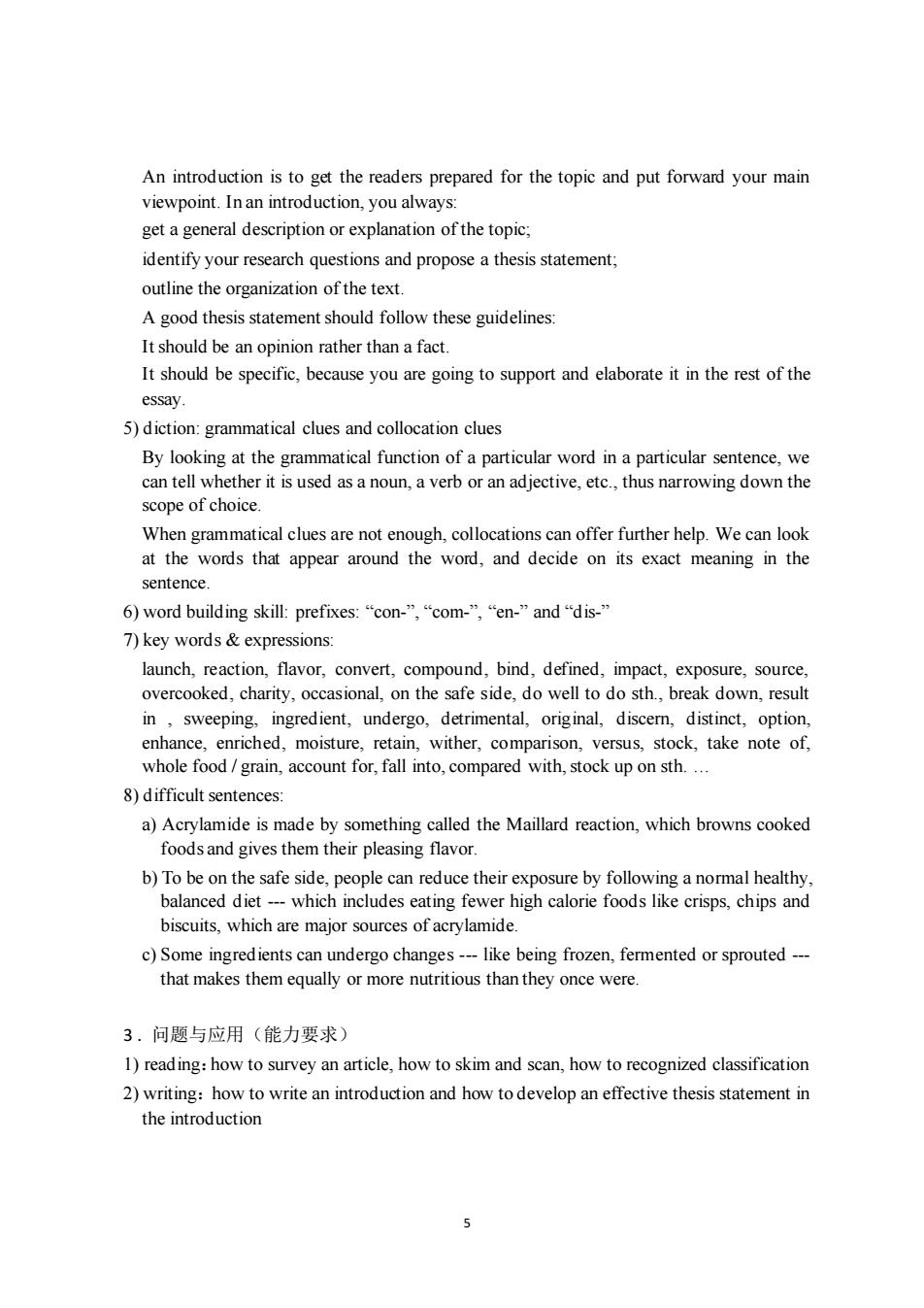
An introduction is to get the readers prepared for the topic and put forward your main viewpoint.Inan introduction,you always: get a general description or explanation of the topic, identify your research questions and propose a thesis statement. outline the organization of the text. A good thesis statement should follow these guidelines It should be an opinion rather than a fact. It should be specific,because you are going to support and elaborate it in the rest of the essav 5)diction:grammatical clues and collocation clues By looking at the grammatical function of a particular word in a particular sentence,we can tell whether it is usd asaoua verbor or an adjective,etc.,thus narrowing down the When grammatical clues are not enough,collocations can offer further help.We can look at the words that appear around the word,and decide on its exact meaning in the sentence. 6)word building skill:prefixes:“con-”,“com-”,“en-”and"dis-” 7)key words&expressions launch,reaction,flavor,convert,compound,bind,defined,impact,exposure,source overcooked,charity,occasional,on the safe side. do well to do sth.break down.resul in,sweeping,ingredient,undergo,detrimental,original,discemn,distinct,option, enhance,enriched,moisture,retain,wither,comparison,versus,stock,take note of, whole food/grain,account for,fall into,compared with,stock up on sth. 8)difficult sentences: a)Acrylamide is made by something called the Maillard reaction,which browns cooked foods and gives them their pleasing flavo b)To be on the safe side.people can reduce their exposure by following a normal healthy balanced diet-which includes eating fewer high calorie foods like crisps,chips and biscuits,which are major sources of acrylamide. c)Some ingredients can undergo changes---like being frozen,fermented or sprouted- that makes them equally or more nutritious than they once were. 3.问题与应用(能力要求) 1)reading:how to survey an article,how to skim and scan,how to recognized classification 2)writing:how to write an introduction and how to develop an effective thesis statement in the introduction
5 An introduction is to get the readers prepared for the topic and put forward your main viewpoint. In an introduction, you always: get a general description or explanation of the topic; identify your research questions and propose a thesis statement; outline the organization of the text. A good thesis statement should follow these guidelines: It should be an opinion rather than a fact. It should be specific, because you are going to support and elaborate it in the rest of the essay. 5) diction: grammatical clues and collocation clues By looking at the grammatical function of a particular word in a particular sentence, we can tell whether it is used as a noun, a verb or an adjective, etc., thus narrowing down the scope of choice. When grammatical clues are not enough, collocations can offer further help. We can look at the words that appear around the word, and decide on its exact meaning in the sentence. 6) word building skill: prefixes: “con-”, “com-”, “en-” and “dis-” 7) key words & expressions: launch, reaction, flavor, convert, compound, bind, defined, impact, exposure, source, overcooked, charity, occasional, on the safe side, do well to do sth., break down, result in , sweeping, ingredient, undergo, detrimental, original, discern, distinct, option, enhance, enriched, moisture, retain, wither, comparison, versus, stock, take note of, whole food / grain, account for, fall into, compared with, stock up on sth. … 8) difficult sentences: a) Acrylamide is made by something called the Maillard reaction, which browns cooked foods and gives them their pleasing flavor. b) To be on the safe side, people can reduce their exposure by following a normal healthy, balanced diet --- which includes eating fewer high calorie foods like crisps, chips and biscuits, which are major sources of acrylamide. c) Some ingredients can undergo changes --- like being frozen, fermented or sprouted --- that makes them equally or more nutritious than they once were. 3 . 问题与应用(能力要求) 1) reading:how to survey an article, how to skim and scan, how to recognized classification 2) writing:how to write an introduction and how to develop an effective thesis statement in the introduction
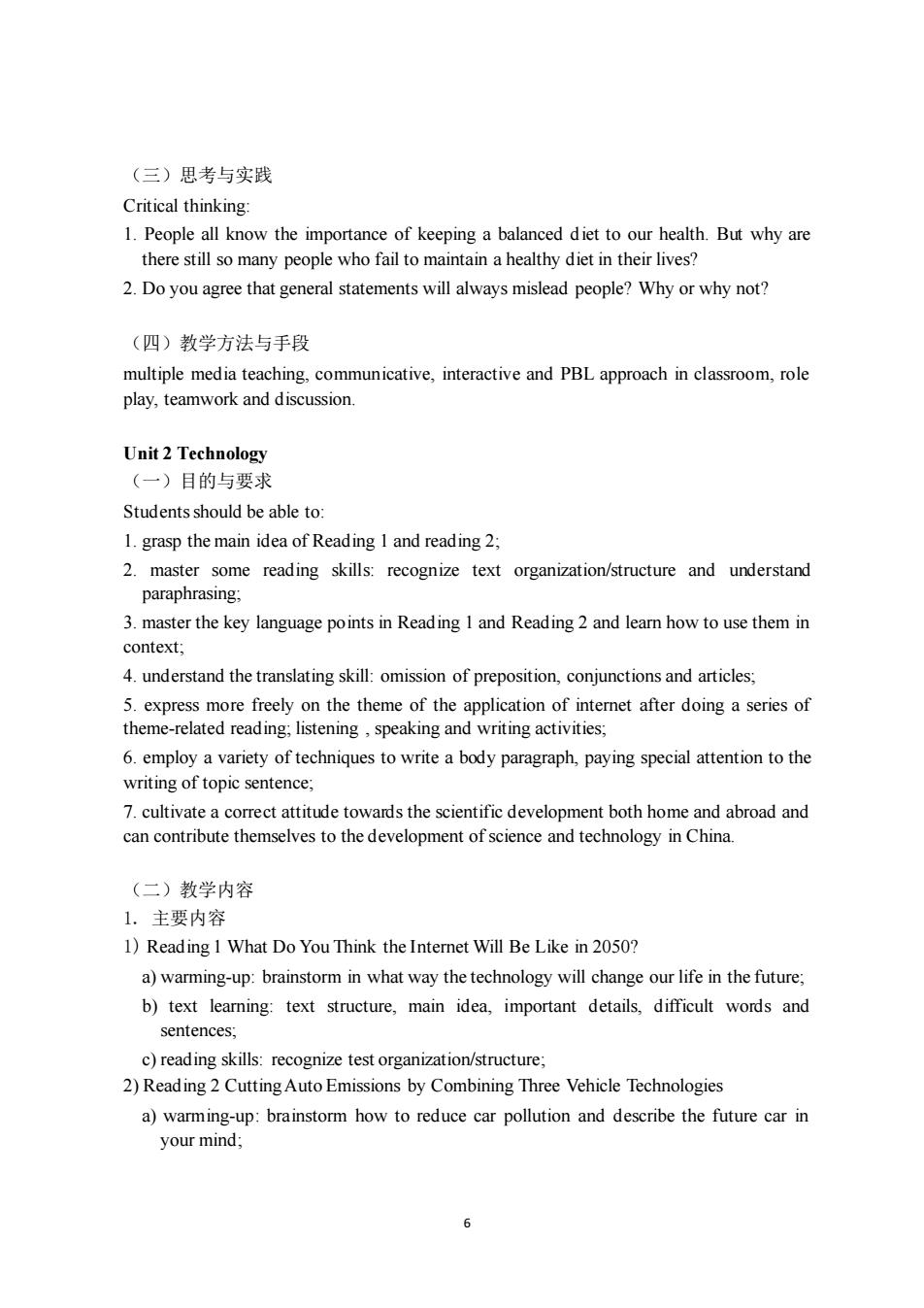
(三)思考与实践 Critical thinking: 1.People all know the importance of keeping a balanced diet to our health.But why are there still so many people who fail to maintain a healthy diet in their lives? 2.Do you agree that general statements will always mislead people?Why or why not? (四)教学方法与手段 multiple media teaching.communicative,interactive and PBL approach in classroom,role play,teamwork and discussion. Unit 2 Technology (一)目的与要求 Students should be able to: 1.grasp the main idea of Reading I and reading 2; 2.master some reading skills:recognize text organization/structure and urderstand paraphrasing: 3.master the key language points in Reading I and Reading 2 and learn how to use them in context: 4.understand the translating skill:omission of preposition,conjunctions and articles; 6.employ a variety of techniques to write a body paragraph,paying special attention to the writing of topic sentence. 7.cultivate a correct attitude towards the scientific development both home and abroad and can contribute themselves to the development of science and technology in China. (二)教学内容 1.主要内容 1)Reading 1 What Do You Think the Internet Will Be Like in 2050? a)warming-up:brainstorm in what way the technology will change our life in the future; b)text leamning:text structure,main idea,important details,difficult words and sentences: c)reading skills:recognize test organization/structure, 2)Reading 2 Cutting Auto Emissions by Combining Three Vehicle Technologies a)warming-up:brainstorm how to reduce car pollution and describe the future car in your mind; 6
6 (三)思考与实践 Critical thinking: 1. People all know the importance of keeping a balanced diet to our health. But why are there still so many people who fail to maintain a healthy diet in their lives? 2. Do you agree that general statements will always mislead people? Why or why not? (四)教学方法与手段 multiple media teaching, communicative, interactive and PBL approach in classroom, role play, teamwork and discussion. Unit 2 Technology (一)目的与要求 Students should be able to: 1. grasp the main idea of Reading 1 and reading 2; 2. master some reading skills: recognize text organization/structure and understand paraphrasing; 3. master the key language points in Reading 1 and Reading 2 and learn how to use them in context; 4. understand the translating skill: omission of preposition, conjunctions and articles; 5. express more freely on the theme of the application of internet after doing a series of theme-related reading; listening , speaking and writing activities; 6. employ a variety of techniques to write a body paragraph, paying special attention to the writing of topic sentence; 7. cultivate a correct attitude towards the scientific development both home and abroad and can contribute themselves to the development of science and technology in China. (二)教学内容 1. 主要内容 1) Reading 1 What Do You Think the Internet Will Be Like in 2050? a) warming-up: brainstorm in what way the technology will change our life in the future; b) text learning: text structure, main idea, important details, difficult words and sentences; c) reading skills: recognize test organization/structure; 2) Reading 2 Cutting Auto Emissions by Combining Three Vehicle Technologies a) warming-up: brainstorm how to reduce car pollution and describe the future car in your mind;
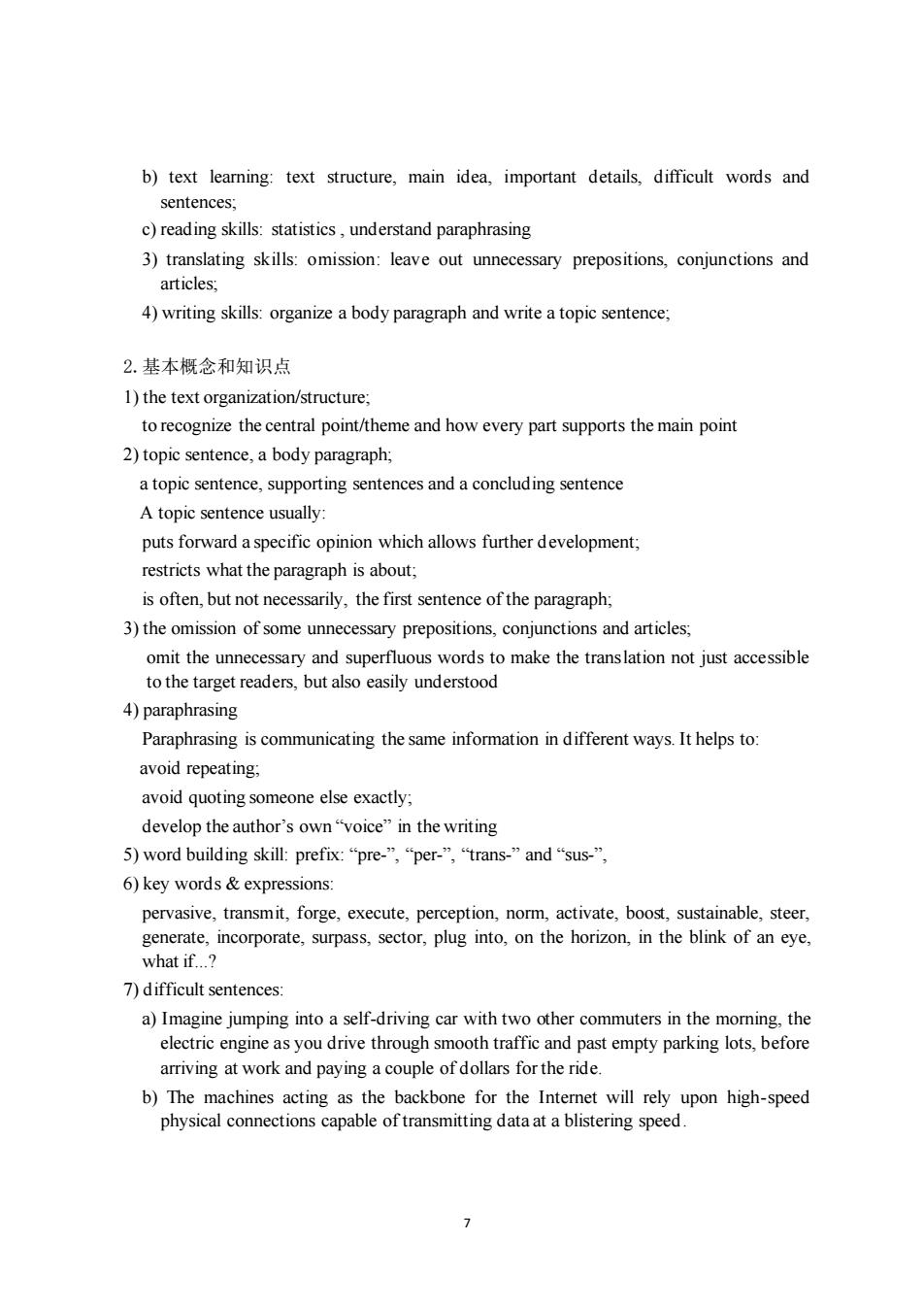
b)text learning:text structure,main idea,important details,difficult words and sentences: c)reading skills:statistics,understand paraphrasing 3)translating skills:omission:leave out unnecessary prepositions,conjunctions and articles; 4)writing skills:organize a body paragraph and write a topic sentence: 2.基本概念和知识点 1)the text organization/structure; to recognize the central point/theme and how every part supports the main point 2)topic sentence,a body paragraph; a topic sentence,supporting sentences and a concluding sentence A topic sentence usually: puts forward a specific opinion which allows further development; restricts what the paragraph is about; is often,but not necessarily,the first sentence of the paragraph; 3)the omission of some unnecessary prepositions,conjunctions and articles. omit the unnecessary and superfluous words to make the translation not just accessible to the target readers,but also easily understoo 4)paraphrasing Paraphrasing is communicating the same information in different ways.It helps to avoid repeating. avoid quoting someone else exactly; develop the author's own"voice"in the writing 5)word building skill::prefix:“pre”,“per-”,“trans-”and“sus-”, 6)key words&expressions pervasive,transmit,forge,execute,perception,nom,activate,boost,sustainable,steer, incorporate,surpass,sector,plug into,on the horizon,in the blink of an eye. whatif..? 7)difficult sentences a)Imagine jumping into a self-driving car with two other commuters in the moming.the electric engine as you drive through smooth traffic and past empty parking lots,before arriving at work and paying a couple of dollars for the ride. b)The machines acting as the backbone for the Internet will rely upon high-speed physical connections capable of transmitting data at a blistering speed. 7
7 b) text learning: text structure, main idea, important details, difficult words and sentences; c) reading skills: statistics , understand paraphrasing 3) translating skills: omission: leave out unnecessary prepositions, conjunctions and articles; 4) writing skills: organize a body paragraph and write a topic sentence; 2.基本概念和知识点 1) the text organization/structure; to recognize the central point/theme and how every part supports the main point 2) topic sentence, a body paragraph; a topic sentence, supporting sentences and a concluding sentence A topic sentence usually: puts forward a specific opinion which allows further development; restricts what the paragraph is about; is often, but not necessarily, the first sentence of the paragraph; 3) the omission of some unnecessary prepositions, conjunctions and articles; omit the unnecessary and superfluous words to make the translation not just accessible to the target readers, but also easily understood 4) paraphrasing Paraphrasing is communicating the same information in different ways. It helps to: avoid repeating; avoid quoting someone else exactly; develop the author’s own “voice” in the writing 5) word building skill: prefix: “pre-”, “per-”, “trans-” and “sus-”, 6) key words & expressions: pervasive, transmit, forge, execute, perception, norm, activate, boost, sustainable, steer, generate, incorporate, surpass, sector, plug into, on the horizon, in the blink of an eye, what if...? 7) difficult sentences: a) Imagine jumping into a self-driving car with two other commuters in the morning, the electric engine as you drive through smooth traffic and past empty parking lots, before arriving at work and paying a couple of dollars for the ride. b) The machines acting as the backbone for the Internet will rely upon high-speed physical connections capable of transmitting data at a blistering speed
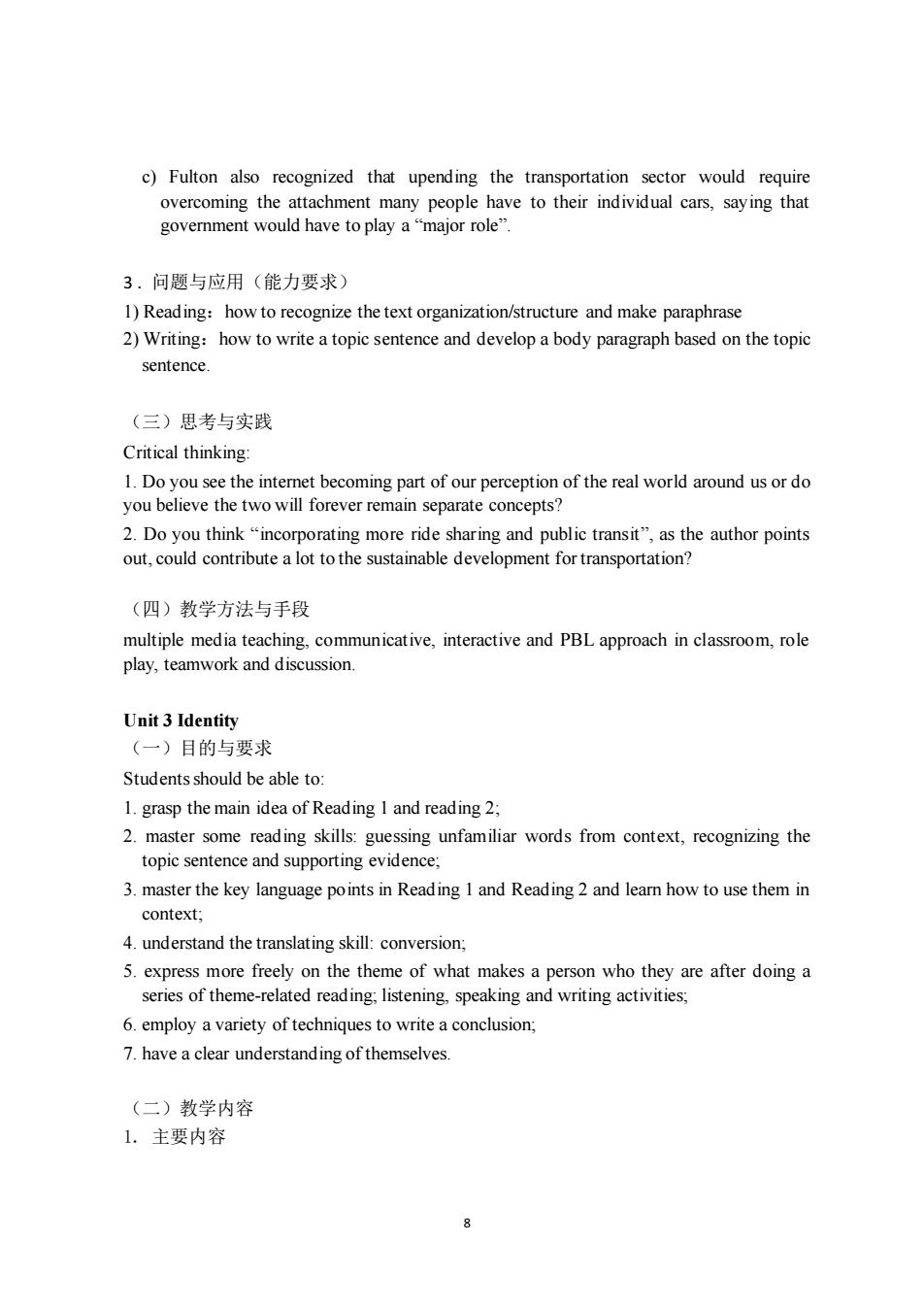
c)Fulton also recognized that upending the transportation sector would require overcoming the attachment many people have to their individual cars,saying that government would have to play a“major role” 3.问题与应用(能力要求) 1)Reading:how to recognize the text organization/structure and make paraphrase 2)Writing:how to write a topic sentence and develop a body paragraph based on the topic sentence. (三)思考与实践 Critical thinking: 1.Do you see the interet becoming part of our perception of the real world around usordo 2.Do you think"incorporating more ride sharing and public transit",as the author points out,could contribute a lot to the sustainable development for transportation? (四)教学方法与手段 multiple media teaching.communicative,interactive and PBL approach in classroom,role play,teamwork and discussion. Unit 3 Identity (一)目的与要求 Studentsshould be able to: 1.grasp the main idea of Reading I and reading 2; 3.master the key language points in Reading I and Reading 2 and learn how to use them in context; 4.understand the translating skill:conversion: 5.expressmore freely on the theme of what makes a person who they are after doing a of theme-relaedeadngsneakngdtni 6.employ a variety of techniques to write a conclusion; 7.have a clear understanding of themselves. (二)教学内容 1.主要内容
8 c) Fulton also recognized that upending the transportation sector would require overcoming the attachment many people have to their individual cars, saying that government would have to play a “major role”. 3 . 问题与应用(能力要求) 1) Reading:how to recognize the text organization/structure and make paraphrase 2) Writing:how to write a topic sentence and develop a body paragraph based on the topic sentence. (三)思考与实践 Critical thinking: 1. Do you see the internet becoming part of our perception of the real world around us or do you believe the two will forever remain separate concepts? 2. Do you think “incorporating more ride sharing and public transit”, as the author points out, could contribute a lot to the sustainable development for transportation? (四)教学方法与手段 multiple media teaching, communicative, interactive and PBL approach in classroom, role play, teamwork and discussion. Unit 3 Identity (一)目的与要求 Students should be able to: 1. grasp the main idea of Reading 1 and reading 2; 2. master some reading skills: guessing unfamiliar words from context, recognizing the topic sentence and supporting evidence; 3. master the key language points in Reading 1 and Reading 2 and learn how to use them in context; 4. understand the translating skill: conversion; 5. express more freely on the theme of what makes a person who they are after doing a series of theme-related reading; listening, speaking and writing activities; 6. employ a variety of techniques to write a conclusion; 7. have a clear understanding of themselves. (二)教学内容 1. 主要内容
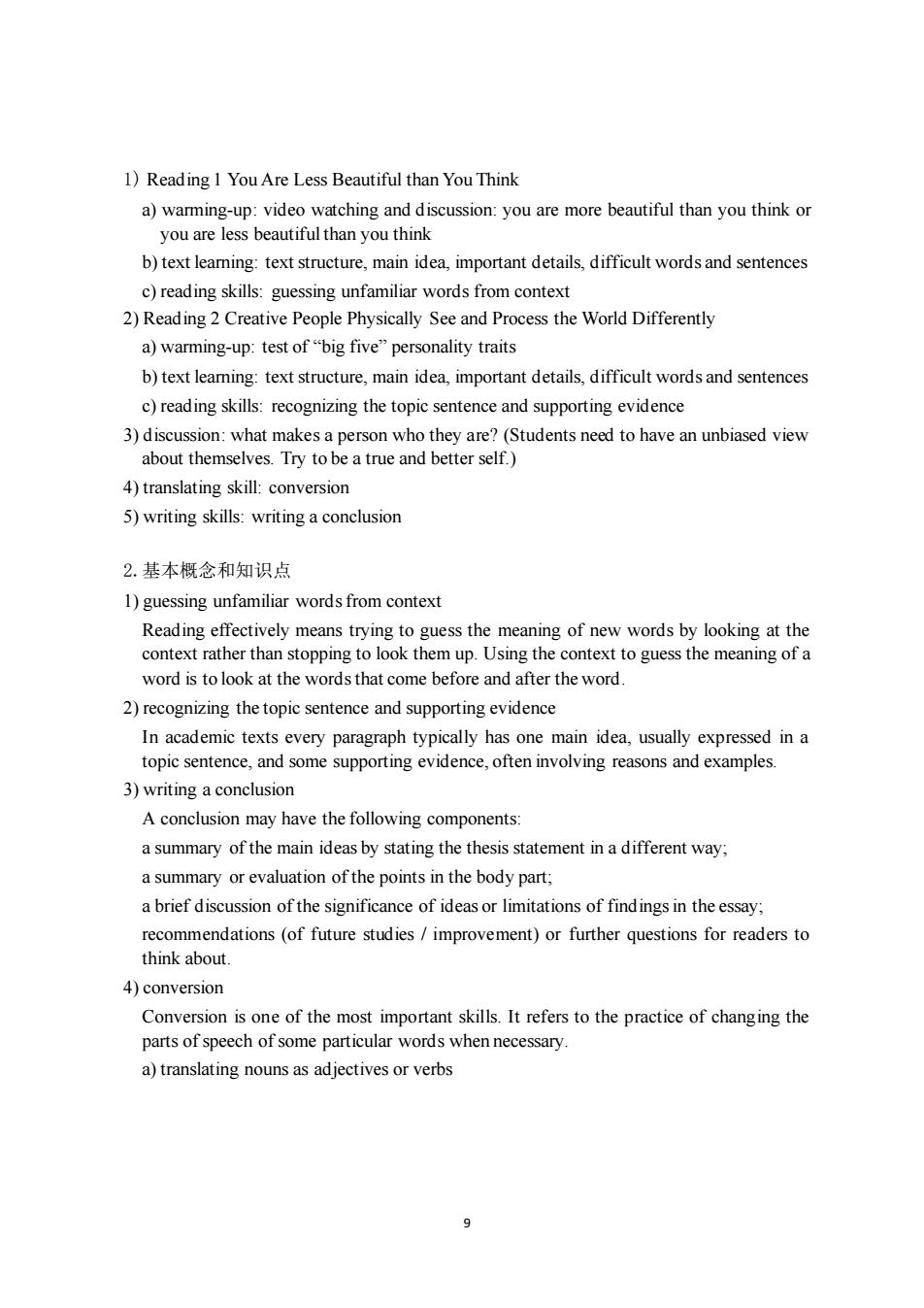
1)Reading I You Are Less Beautiful than You Think a)warming-up:video watching and discussion:you are more beautiful than you think or you are less beautiful than you think b)text leaming:text structure,main idea,important details,difficult words and sentences c)reading skills:guessing unfamiliar words from context 2)Reading 2 Creative People Physically See and Process the World Differently a)warming-up:test of"big five"personality traits b)text leaming:text structure,main idea,important details,difficult words and sentences c)reading skills:recognizing the topic sentence and supporting evidence 3)discussion:what makes a person who they are?(Students need to have an unbiased view about themselves.Try to be a true and better self.) 4)translating skill:conversion 5)writing skills:writing a conclusior 2基本概念和知识点 1)guessing unfamiliar words from context Reading effectively means trying to guess the meaning of new words by looking at the context rather than stopping to look them up.Using the context to guess the meaning of a word is to look at the words that come before and after the word. 2)recognizing the topic sentence and supporting evidence In academic texts every paragraph typically has one main idea,usually expres ssed in a topic sentence,and some supporting evidence,often involving reasons and examples 3)writing a conclusion A conclusion may have the following components: a summary of the main ideas by stating the thesis statement in a different way: a summary or evaluation of the points in the body part: a brief discussion of the significance of ideas or limitations of findings in the essay, recommendations (of future studies /improvement)or further questions for readers to think about. 4)conversion Conversion is one of the most important skills.It refers to the practice of changing the parts of speech of some particular words when necessary. a)translating nouns as adjectives or verbs
9 1) Reading 1 You Are Less Beautiful than You Think a) warming-up: video watching and discussion: you are more beautiful than you think or you are less beautiful than you think b) text learning: text structure, main idea, important details, difficult words and sentences c) reading skills: guessing unfamiliar words from context 2) Reading 2 Creative People Physically See and Process the World Differently a) warming-up: test of “big five” personality traits b) text learning: text structure, main idea, important details, difficult words and sentences c) reading skills: recognizing the topic sentence and supporting evidence 3) discussion: what makes a person who they are? (Students need to have an unbiased view about themselves. Try to be a true and better self.) 4) translating skill: conversion 5) writing skills: writing a conclusion 2.基本概念和知识点 1) guessing unfamiliar words from context Reading effectively means trying to guess the meaning of new words by looking at the context rather than stopping to look them up. Using the context to guess the meaning of a word is to look at the words that come before and after the word. 2) recognizing the topic sentence and supporting evidence In academic texts every paragraph typically has one main idea, usually expressed in a topic sentence, and some supporting evidence, often involving reasons and examples. 3) writing a conclusion A conclusion may have the following components: a summary of the main ideas by stating the thesis statement in a different way; a summary or evaluation of the points in the body part; a brief discussion of the significance of ideas or limitations of findings in the essay; recommendations (of future studies / improvement) or further questions for readers to think about. 4) conversion Conversion is one of the most important skills. It refers to the practice of changing the parts of speech of some particular words when necessary. a) translating nouns as adjectives or verbs
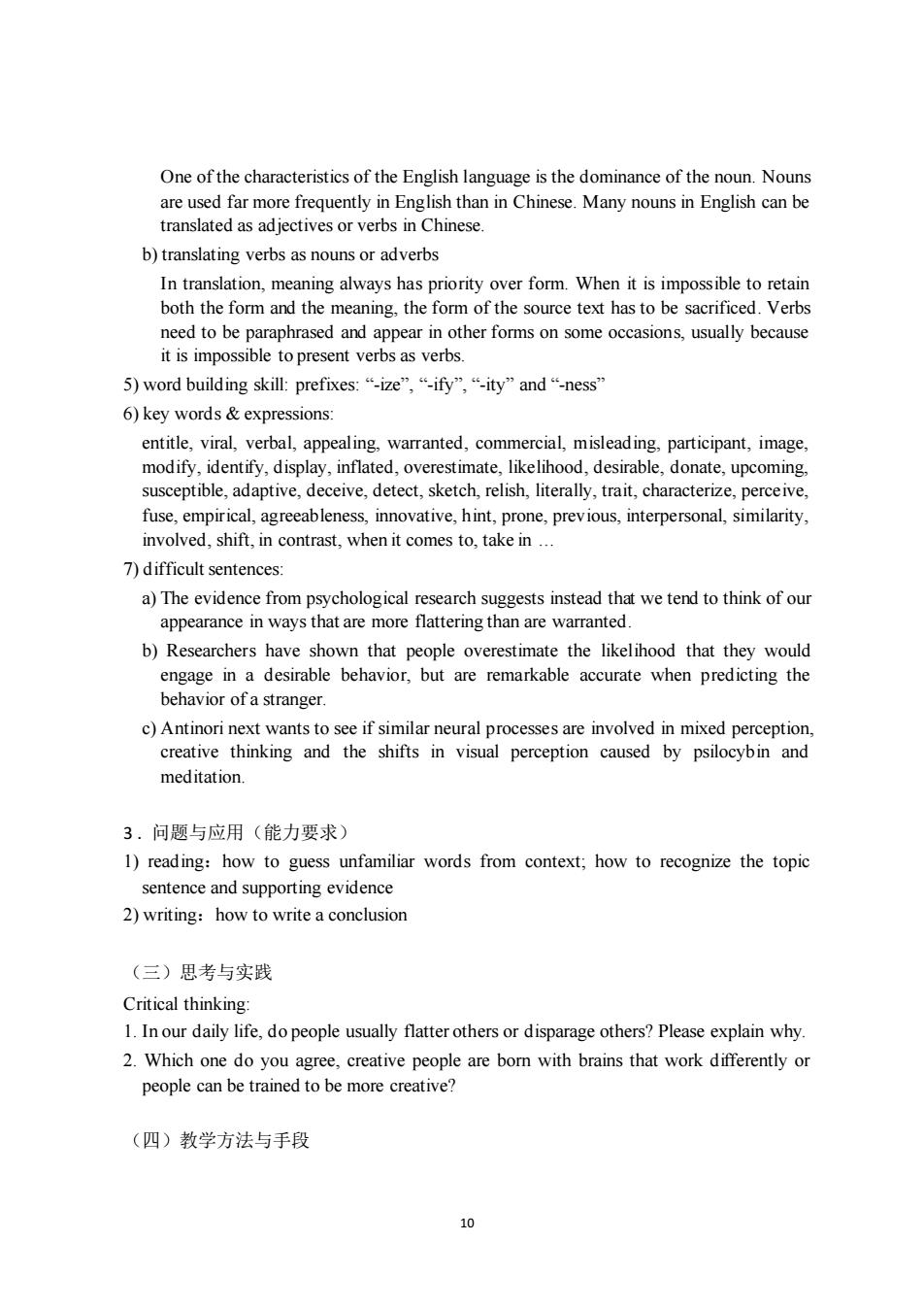
One of the characteristics of the English language is the dominance of the noun.Nouns are used far more frequently in English than in Chinese.Many nouns in English can be translated as adiectives or verbs in chinese b)translating verbs as nouns or adverbs In translation,meaning always has priority ver form.When it is impossible to reta both the form and the meaning,the form of the source text has to be sacrificed.Verbs need to be paraphrased and appear in other forms on some occasions,usually because it is impossible to present verbs as verbs. 5)word building skill:prefixes::“-ize”,“ify”,“-ity”and“-ness 6)key words expressions: entitle,viral,verbal,appealing,warranted,commercial,misleading,participant,image. modify,identify,display,inflated,overestimate,likelihood,desirable,donate,upcoming. susceptible,adaptive,deceive,detect,sketch,relish,literally,trait,characterize,perceive fuse,e 7)difficult sentences a)The evidence from psychological research suggests instead that we tend to think of our appearance in ways that are more flattering than are warranted. b)Researchers have shown that people overestimate the likelihood that they would engage in a desirable behavior,but are remarkable accurate when predicting the behavior of a stranger. )Antinori next wants to see if similar neural p meditation. 3.问题与应用(能力要求) 1)reading:how to guess unfamiliar words from context:how to recognize the topic sentence and supporting evidence 2)writing:how to write a conclusion (三)思考与实践 Critical thinking 1.In our daily life.do people usually flatter others or disparage others?Please explain why. 2.Which one do you agree,creative people are bom with brains that work differently or people can be trained to be more creative? (四)教学方法与手段 10
10 One of the characteristics of the English language is the dominance of the noun. Nouns are used far more frequently in English than in Chinese. Many nouns in English can be translated as adjectives or verbs in Chinese. b) translating verbs as nouns or adverbs In translation, meaning always has priority over form. When it is impossible to retain both the form and the meaning, the form of the source text has to be sacrificed. Verbs need to be paraphrased and appear in other forms on some occasions, usually because it is impossible to present verbs as verbs. 5) word building skill: prefixes: “-ize”, “-ify”, “-ity” and “-ness” 6) key words & expressions: entitle, viral, verbal, appealing, warranted, commercial, misleading, participant, image, modify, identify, display, inflated, overestimate, likelihood, desirable, donate, upcoming, susceptible, adaptive, deceive, detect, sketch, relish, literally, trait, characterize, perceive, fuse, empirical, agreeableness, innovative, hint, prone, previous, interpersonal, similarity, involved, shift, in contrast, when it comes to, take in … 7) difficult sentences: a) The evidence from psychological research suggests instead that we tend to think of our appearance in ways that are more flattering than are warranted. b) Researchers have shown that people overestimate the likelihood that they would engage in a desirable behavior, but are remarkable accurate when predicting the behavior of a stranger. c) Antinori next wants to see if similar neural processes are involved in mixed perception, creative thinking and the shifts in visual perception caused by psilocybin and meditation. 3 . 问题与应用(能力要求) 1) reading:how to guess unfamiliar words from context; how to recognize the topic sentence and supporting evidence 2) writing:how to write a conclusion (三)思考与实践 Critical thinking: 1. In our daily life, do people usually flatter others or disparage others? Please explain why. 2. Which one do you agree, creative people are born with brains that work differently or people can be trained to be more creative? (四)教学方法与手段